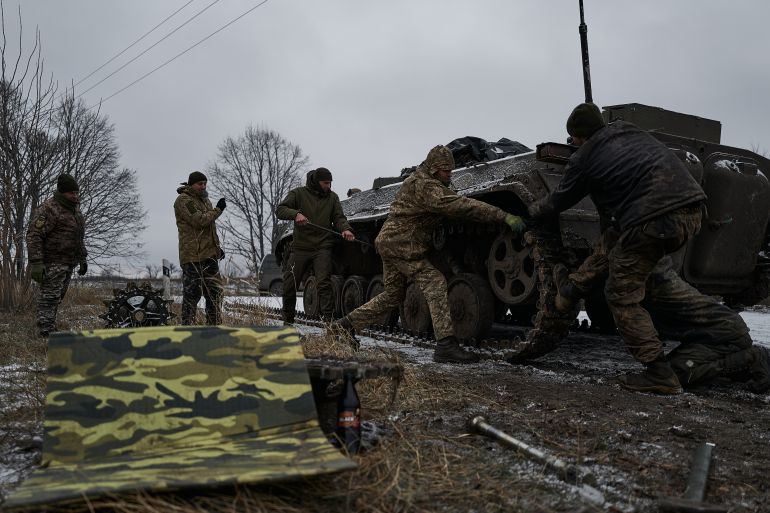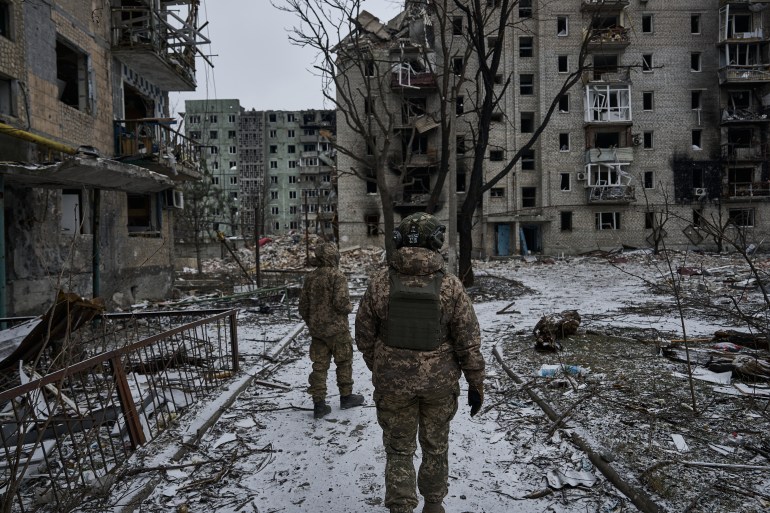Analysis: Russia’s tiny, Pyrrhic advances in Ukraine’s east
Russia is making incremental inroads in eastern Ukraine and may soon hold the strategic town of Avdiivka.

Kyiv, Ukraine – Russian forces are close to rolling into a Ukrainian stronghold of immense strategic and symbolic importance.
Troops have almost surrounded Avdiivka, a southeastern town which has been nearly razed to the ground after almost a decade of assaults by pro-Moscow separatist fighters.
Keep reading
list of 4 itemsUN monitors say North Korean missile struck Ukraine’s Kharkiv
Russia-Ukraine war: List of key events, day 796
Polish farmers suspend blockade of Ukraine border
The town is strewn with craters from explosions, burned-out armoured vehicles and the uncollected bodies of Russian soldiers and separatists who doubled their efforts in October.
Avdiivka is just 20km (12 miles) north of the separatist capital of Donetsk and is crucial to the Kremlin’s objective of seizing the entire southeastern Donbas region that has been partly controlled by rebels since 2014.
The Kremlin shifted to this strategy a year ago after its blitzkrieg to conquer all of Ukraine failed and its forces withdrew from around Kyiv and most of Ukraine’s north.
But Kyiv’s long-awaited summer counteroffensive to regain areas lost to Russia last year hasn’t yielded tangible results. Ukrainian forces lack air support and medium-range missiles to disrupt Russian supply lines and break through heavily fortified Russian defence installations along the crescent-shaped, 1,000km-long front line.
Counterattacking Ukrainian forces largely consist of recently trained servicemen who replaced dead and wounded veterans. They lack battlefield cohesion and had not expected to encounter thousands of kilometres of newly built Russian trenches and tunnels, some of which lie 30 metres (33 yards) underground.
Moscow has also deployed hundreds of thousands of newly mobilised servicemen to man the defence lines and plant up to five landmines per single square metre of no-man’s land.
As a result, Ukrainian forces have failed to achieve their goal of reaching the Sea of Azov and cutting off Russia’s “land bridge” to the annexed Crimean peninsula amid heavy, debilitating losses of manpower and weaponry, including Western-supplied armoured vehicles.
Ukraine’s top military analyst warned that in the freezing winter months, the nation’s military will have to circle the wagons and focus on defence as they re-evaluate next year’s offence strategy with Western allies, increase domestic production of weaponry and mobilise tens of thousands more men.
“These days, we are focusing on switching to defence, and, to boost its effectiveness, to equipping and mining the most threatening [front-line] areas and use this time to amass resources,” Lieutenant General Ihor Romanenko, former deputy chief of the General Staff of the Ukrainian Armed Forces, told Al Jazeera.
He and other analysts blame Ukraine’s failures on delays in supplies of Western weaponry as well as Russia’s prowess in the large-scale use of unmanned aerial vehicles, especially the FPV (first-person view) kamikaze drones.
These inexpensive camera-equipped drones carry tiny explosives and can get into manholes or open hatches of armoured vehicles – all while their pilots operate them from safe hideouts.
This year, Russia began the massive industrial production of FPV drones, while Ukraine still largely relies on the output of makeshift workshops, the numbers of which have mushroomed around the nation and where volunteers retrofit Chinese-made models.
“This year, [Russians] managed to catch up with us and go ahead of us, and to produce large quantities of unmanned aerial vehicles,” Romanenko said.
However, some analysts claim the advantages of FPV drones are somewhat exaggerated.
“They’re cheaper and more simple, but also less effective in comparison with high-precision means of destruction, including advanced kinds of loitering munitions,” Pavel Luzin, a visiting scholar at Boston’s Tufts University, told Al Jazeera.

Taking The Chemist
To take over Avdiivka, Russian forces have to seize The Chemist, a district named after a nearby plant, according to Rybar, a pro-Russian Telegram channel.
“This will let them bisect the Ukrainian grouping in Avdiivka, to break the unified system of defence and to significantly simplify the storming of the entire defence site,” Rybar, a primary source of news on the Russian offensive, posted on Monday.
Moscow needs to take Avdiivka for publicity purposes. Russian President Vladimir Putin has announced that he will run in the 2024 election and needs a victory that the Kremlin-controlled media can trumpet.
“Putin needs such a victory ahead of the vote considering that the situation on the front lines is in a limbo for both sides,” Kyiv-based analyst Igar Tyshkevich told Al Jazeera.
The Kremlin and its top brass largely ignore the plight of their servicemen who reach the front lines after no or next-to-no training and have been dying in droves.
“To trudge two kilometres across the forest only to jump a machine gun and die within two seconds is the real-life story of a Russian stormtrooper,” a Ukrainian serviceman wrote on Telegram in August.
This has led to catastrophic losses.
Some 315,000 Russian servicemen have been killed or wounded since the war began in February 2022, amounting to 87 percent of Moscow’s active-duty ground troops, according to a declassified US military assessment released on Tuesday.
Apart from the incessant storming of Avdiivka, Russian forces also intend to advance on other key areas of the eastern front – the towns of Kupiansk, Lyman and Bakhmut.
The latter was taken over in May, mostly by Wagner mercenaries leading thousands of Russian prisoners who signed up for military service in exchange for a presidential pardon in what became known as “meat marches”.
Over the following months, Ukraine retook key positions around Bakhmut – and Russians are dying in a bid to take them back.
But real military triumphs are just not on the cards for Moscow, another analyst said.
“One should not expect any breakthroughs for Russian forces. They hit in various directions, just a little. Spend the ammo they amassed, as well as contract soldiers and [recruited] inmates,” Nikolay Mitrokhin of Germany’s Bremen University told Al Jazeera.
Russian forces may manage to seize Avdiivka, are likely to restore their positions around Bakhmut and improve their logistics by crossing the Zherebets river near Lyman, he said.
“Russia will consider [these steps] the winter campaign’s large victory,” Mitrokhin said.
At that stage, Moscow is likely to run out of soldiers and weaponry but, “this will constitute more territorial gains than those of Ukraine this year”, Mitrokhin added.
No matter how minuscule, Russian advances will surely block any Ukrainian advance on the southern front, Mitrokhin said.

Ukrainian pushback
Further south, on the Black Sea, Ukraine has the upper hand, however.
During 2023, its sea and aerial drones downed several Russian warships and forced Moscow to relocate most of its Black Sea Fleet from annexed Crimea to the port of Novorossiysk.
This has significantly reduced the shelling of Ukrainian coastal cities – and helped revive the “grain corridor” through which Ukrainian wheat is shipped to the Mediterranean.
“That’s how we secured the functioning of the grain corridor,” Romanenko said.
Meanwhile, Ukrainian intelligence has made inroads deep within enemy territory.
Ilya Kyva, a controversial Ukrainian lawmaker with a pro-Moscow party who called for the mass killing of homosexuals and fled to Russia shortly before the war, was shot dead outside Moscow on December 6.
He was reportedly about to record a video urging Ukrainian President Volodymyr Zelenskyy to kill himself.
Ukrainian media claimed the SBU, Ukraine’s main intelligence agency, was behind the killing.
On December 1, explosions blamed on Ukrainian intelligence derailed two cargo trains on the strategic Baikal-Amur railway, paralysing Russia’s key transport link to China, North Korea and Japan.
Russia announced the arrest of a Belarusian national with links to the SBU who allegedly planted the explosives.
“The blowup of two fuel-loaded trains in a row, thousands of kilometres away from the front lines, in a strategic tunnel and at a detour line to paralyse central Russia’s and Siberia’s connection with the Far East, as well as China, North Korea and Japan, is an absolutely unique operation,” analyst Mitrokhin said.